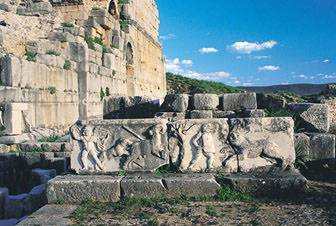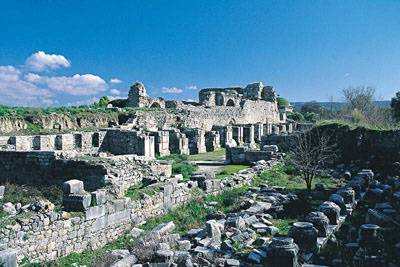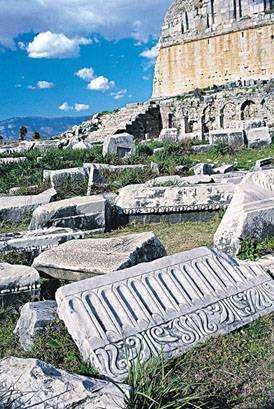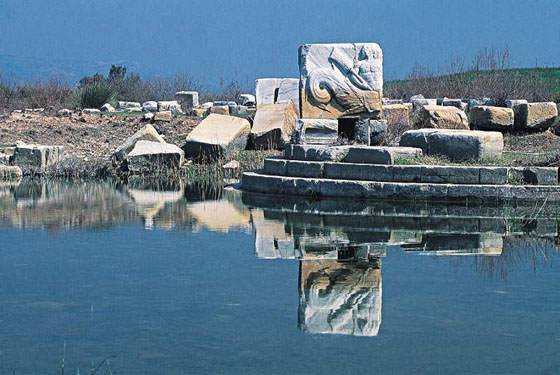Miletos
 When
Neleus, son of King Kodros of Athens, decided to found a city, the gods told him that he
must choose a site where the earth of a young maiden mingled with water. Neleus wandered
through Anatolia until he came to a place where a young girl named Kaeira was collecting
clay from a river bed with which to make pots. Remembering what the gods had said, Neleus
founded his city here. This was to be the celebrated Miletus. When
Neleus, son of King Kodros of Athens, decided to found a city, the gods told him that he
must choose a site where the earth of a young maiden mingled with water. Neleus wandered
through Anatolia until he came to a place where a young girl named Kaeira was collecting
clay from a river bed with which to make pots. Remembering what the gods had said, Neleus
founded his city here. This was to be the celebrated Miletus.
Another version of the founding myth of the city relates that Akakallis, daughter of
the King of Crete, bore a child, Miletus, to the god Apollo. Afraid of her father King
Minos, however, she abandoned it in the forest. Wolves cared for the baby, which was
subsequently found by shepherds and brought up by them. Years later Miletus sailed to
Anatolia, where he founded a city in his name. Later he married Kyane, daughter of the god
Maiandros of the Meander river, and they had two children named Kaunos and Biblys.
 Whatever
the claims of these respective stories, Miletus became a renowned centre of scholarship
and art. It was here that the positive sciences were born, and where the celebrated
natural philosopher Thales first predicted a solar eclipse in 585 BC. Other famous
philosophers such as Anaximenes and Anaximandros, and Hippodamos, an innovator in the
field of city planning and after whom the grid plan was named, were from Miletus. Daphnis
who built the Temple of Apollo, and Isidorus, architect of Haghia Sophia in Istanbul, were
both from the city. So were Aristeides, author of the obscene Miletus Tales, the first
geographer Hecataios, and Leucippos who posited the existence of atoms. Aspasia, mistress
of the Athenian statesman Pericles, was born here. Miletus was a thriving centre of trade
which founded more than ninety trading colonies, including Samsun and Giresun on the Black
Sea coast. Whatever
the claims of these respective stories, Miletus became a renowned centre of scholarship
and art. It was here that the positive sciences were born, and where the celebrated
natural philosopher Thales first predicted a solar eclipse in 585 BC. Other famous
philosophers such as Anaximenes and Anaximandros, and Hippodamos, an innovator in the
field of city planning and after whom the grid plan was named, were from Miletus. Daphnis
who built the Temple of Apollo, and Isidorus, architect of Haghia Sophia in Istanbul, were
both from the city. So were Aristeides, author of the obscene Miletus Tales, the first
geographer Hecataios, and Leucippos who posited the existence of atoms. Aspasia, mistress
of the Athenian statesman Pericles, was born here. Miletus was a thriving centre of trade
which founded more than ninety trading colonies, including Samsun and Giresun on the Black
Sea coast.
 The
Milesians were known for their rationality, and could even better the gods in argument, as
one legend illustrates: One day Zeus was debating with a poor man in the city agora. Both
were determined not to give in to the other. Finally Zeus shouted angrily, Look here,
do not go too far or I will destroy you with a thunderbolt! His opponent said, See,
great Zeus. You have proved that you are wrong. Another story relates to the
citizens love of animals. The
Milesians were known for their rationality, and could even better the gods in argument, as
one legend illustrates: One day Zeus was debating with a poor man in the city agora. Both
were determined not to give in to the other. Finally Zeus shouted angrily, Look here,
do not go too far or I will destroy you with a thunderbolt! His opponent said, See,
great Zeus. You have proved that you are wrong. Another story relates to the
citizens love of animals.
One day a man named Koaranus purchased a dolphin that had been caught by a fisherman
and returned it to the sea. Some time passed and Koaranus was on a voyage when his ship
sank, but he was saved from drowning by dolphins which carried him to the shore. Years
later when Koaranus died, as his funeral procession passed by the harbour, a shoal of
dolphins was seen to slowly follow it along.
The ancient city of Miletus was once one of western Anatolias most important ports,
but is now stranded 10 kilometres inland. It is situated south of İzmir, in the province
of Aydın, 20 kilometres north of Didyma. The theatre here is
one of the best preserved in Anatolia, and once sat twenty thousand people. The Faustina
Baths are one of the largest ancient baths in Turkey. Other ancient remains are a
Hellenistic storage building, Temple of Serapis, stoa, harbour monument, Temple of Athena,
nymphaion, Temple of Dionysus, Capito Baths, heroons, and two agoras.
There are also monuments dating from mediaeval Turkish times: İlyas Bey Mosque and
complex, Beylik Hamam, a kervansaray, Kırk Merdivenli Mosque, a dervish lodge, and Pireli
Han.
Miletus was first settled as early as the 5th millenium BC, and its heyday was the 5th
and 6th centuries BC. In 494 BC the city was razed following a Persian victory at the
naval battle off the island of Lade (now a hill 4 kilometres from the city), but rebuilt
according to a plan designed by Hippodamus. There are also monuments dating from mediaeval
Turkish times: İlyas Bey Mosque and complex, Beylik Hamam, a kervansaray, Kırk
Merdivenli Mosque, a dervish lodge, and Pireli Han.

The city retained some of its importance through Roman and Byzantine times, but as the
four harbours silted up it gradually declined. The city was still inhabited under the
Turkish Menteşeoğlu principality and early Ottoman times, when it continued to trade
with Venice and Genoa, but finally it was reduced to no more than a village, named Balat,
which was abandoned entirely in 1955.
A team of German archaeologists is currently engaged in excavating Miletus, whose
museum houses finds from Priene and Didyma as well as Miletus. Despite its now landlocked
position, you can still sit on the tiers of seats in the theatre and watch the sun dip
into the distant sea across the alluvial plain of the Meander. |